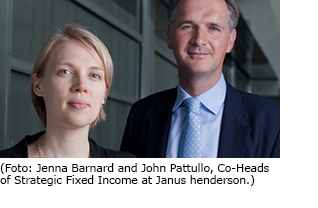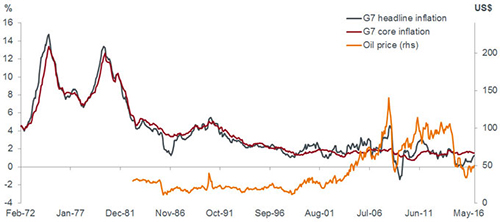
Janus Henderson: Inflation — the dog that never barks
The biggest surprise last year was not only the persistent mis-forecasting of bond yields but also the persistent mis-forecasting of inflation. John Pattullo and Jenna Barnard, Co-Heads of Strategic Fixed Income, have written extensively about how a traditional economics training can be detrimental to a career in the bond markets.
19.01.2018 | 09:10 Uhr
 Why? Because a lot of those traditional models, assumptions and relationships do not seem to hold in this rather dystopian world in which we live. The world’s major central banks seem to be having a crisis of confidence themselves as their models no longer seem to work. Janet Yellen, Chair of the US Federal Reserve (Fed), has acknowledged the puzzle of why inflation is not stronger. She has been dismissing the weakness of inflation as being transitory for many years now! Given that we have printed over $12 trillion through quantitative easing (QE) you would expect inflation to have reared its head by now. Having said that, in a normal cycle inflation does rise late in the cycle and is generally met by rising interest rates, tight labour markets, high oil prices and flattening yield curves.
Why? Because a lot of those traditional models, assumptions and relationships do not seem to hold in this rather dystopian world in which we live. The world’s major central banks seem to be having a crisis of confidence themselves as their models no longer seem to work. Janet Yellen, Chair of the US Federal Reserve (Fed), has acknowledged the puzzle of why inflation is not stronger. She has been dismissing the weakness of inflation as being transitory for many years now! Given that we have printed over $12 trillion through quantitative easing (QE) you would expect inflation to have reared its head by now. Having said that, in a normal cycle inflation does rise late in the cycle and is generally met by rising interest rates, tight labour markets, high oil prices and flattening yield curves.
As former Fed Governor Daniel Tarullo said in October of last year “…we do not, at present, have a theory of inflation dynamics that works sufficiently well to be of use for the business of real time monetary policymaking.”
The three ‘D’s and the macro outlook

We have been at pains to explain that this cycle is very different. We have written extensively about the three ‘D’s of: tech disruption (Amazonisation), ageing demographics1 (Harry Dent), and the debt trap2(Richard Koo). These all chime with the now consensual view expressed by Larry Summer’s secular stagnation thesis3. We really struggle to see how economies can reach ‘escape velocity’. The US has basically plodded along at 2% economic growth for the last six years. We accept it may be nearer to 3% this year but that may be the exception, not the rule.
The good news is that we are experiencing a cyclical upturn in the world economy, driven by the Chinese credit impulse, weaker dollar/cheap emerging market (EM) funding, a bounce in energy capex and loose global financial conditions. We would suggest this cyclical uptick should not be confused with the long-term structural reasons impeding growth and inflation. However, if one was to make the case for a structural breakout in inflation (and inflation expectations) now is not a bad starting point: decent growth; tight labour markets; a high oil price; strong equity markets, and confident businesses and consumers!
Throw out the old economics books
We have had considerable success in dismissing conventional economics and instead focusing our thinking on the Japanese experience to determine the macroeconomic outlook. Hence we have been long duration (interest rate sensitivity) for much of the last five years — completely against consensual thinking. Much of our client base remain very short of duration and of bonds in general, and instead sit content and overweight in illiquid alternative assets. Unfortunately, they are probably working from the same economics books that we once used! We have already written about the broken Phillips curve (Broken curves: are misguided inflation measures leading to policy mistakes?). The lack of wage growth seems to be a global phenomenon. But let us first explain the conventional but potentially flawed model and then give you our take on the modern gig economy.

The stylised model is of an economy making one product, in one factory, with one homogenous workforce (realistic I hear you say). Anyway, assuming the economy is running too hot, the factory owner needs to pay the workers more to expand output (for example, run an extra shift or work overtime). Since labour costs have gone up (ie, input costs) he then passes this cost onto the customers by raising his selling price — thus goods price inflation increases. The workers see this and demand a wage rise and you get a goods/wages price spiral. 1970s here we come?
A little confusion in the markets
Now, do we live in this world? No! However, we do accept there is some evidence of rising wages at the lower end in the US and the UK, primarily due to minimum wage inflation, and at the top end, such as google programmers. Further, a number of states and indeed industries are reporting some wage pressure. But the key point is that we see virtually no evidence that rising input prices are being pushed through to top lines (the selling prices that contribute to a company’s sales revenue, the first line in an accounting income statement). Indeed, in this transparent world with plenty of capacity it is very hard to push up prices and get away with it! Sure there are a few isolated industries but nothing material in our opinion. Again, do not confuse a cyclical uptick with a structural breakout in inflation and growth. This cycle’s amplitude is much lower and longer than previous cycles as we have written about recently (Square root recovery).
Time for an illustration …
A good example of this lack of pass-through of increasing wage costs is Whitbread, the leisure group that owns Costa Coffee. Now the barista is getting a more reasonable wage due to minimum wage legislation but Whitbread’s response to this is a £150m cost saving programme to absorb this cost (and the extra cost of importing coffee due to the depreciation of sterling post the Brexit vote).
Again, some clients confuse imported inflation, which we see purely as a cost or a tax, with excess of demand inflation (demand pull). This is highly topical in the inflation debate as some of the inflation is in ‘non-discretionary’ costs, such as healthcare and housing. Walmart’s recent announcement that it is raising its starting wage to US$11 an hour is topical. Arguably, the US retail giant is sharing the windfall gain of the corporate tax reforms with its employees. Wage costs will rise, but will this cause Walmart to put up prices? I think not! The next day Walmart announced they were cutting thousands of store manager positions and adding new lower paid positions! In addition, they announced they were closing 63 (roughly 10%) of Sam’s club stores with 1000’s of redundancies. 12 of these clubs will be converted to e-commerce fulfilment centres — they are increasing their technology spend to compete with Amazon!
The nature of work is changing
Further, we read a lot about the hollowing out of middle and low incomes — real wage increases are hard to demand or find. Work is now more divisible, transparent and flexible. The Trump administration originally talked about a robot tax. Now they are discussing a capital allowance tax break to replace labour with capital. Robotics and artificial intelligence seem very deflationary to us. We also have part-time labour, zero hour contracts and a lack of trade union power. Indeed, we arguably have an underclass of job takers who live a very ‘precariat’4existence; example: the Uber driver, being an hourly price taker!
The deceptive headline inflation
As always, the Fed’s reaction function to all this is key. They have raised rates five times with inflation below target. So, you have to argue they are more concerned about loose financial conditions and potential wage inflation than targeted personal consumption expenditures (PCE) inflation. They also target other core types of inflation ie, consumer prices index (CPI) and producer prices index (PPI). Even here we need to be super careful — core or underlying inflation has done remarkably little for a very long time. This excludes volatile items such as food and energy.
Some equity managers get overexcited when a rising oil price causes headline inflation to rise, whereas some parts of the bond community get overexcited when falling oil prices cause headline inflation to sink dramatically. Even core CPI has a few oddities in it — a major part is an implied rent cost for housing — recently this has been high but it is expected to fall. Second-hand car prices post the hurricane and aggressive mobile phone price deflation can cause these rates to oscillate around. Again, we do not expect a structural breakout in core underlying inflation! As the chart shows, core inflation in the G7 has been hovering closely around the 2% level for a number of years now.
G7 inflation and crude oil price history

Source: Bloomberg, Janus Henderson Investors, as at 31 December 2017.
A Trichet moment?
Some commentators argue the strength of the global economy has given other central banks the collective ‘cloud cover’ to raise rates. Certainly, after the Sintra BIS meeting, central banks do seem to be targeting financial conditions and arguably rightly so. So, it is not so much that we worry about inflation rearing its head, rather, people and markets will (or may) worry about it. The Trump fiscal reforms and potential infrastructure spending seem ill-timed given where we are in the cycle (surely keep your fire power for bad times?). This, combined with some evidence of rising wages (not necessary passed through to CPI) will give the Fed the opportunity and certainly justification to raise rates. Arguably, the problem is the narrow targeting of inflation rather than a much broader definition of financial conditions and asset price inflation. So, we could continue to see the Fed raise rates with conventional inflation below target — how extraordinary! We remember when Mr Trichet, President of the European Central Bank, rather famously and misguidedly raised rates twice in 2011 with the euro-dollar exchange rate at 1.4 and the oil price at US$110. Sure, the energy cycle dances to a different tune but hey, that was a legendary policy mistake.
Waiting for the dog to bark?
Rightly or wrongly, risk markets are experiencing a melt-up. Financial conditions remain very loose, the oil price is high and now we have an ill-timed fiscal expansion. We expect the market to discount higher rates and more growth than a few weeks ago. We also expect the market to focus on higher wage inflation and infer it gets passed to consumer inflation. So, we are not fighting this quite significant cyclical uptick. We expect it to fade in the second half but we need to get there first. We remain shorter duration than normal, expecting cyclical factors to outshine the long-term structural factors for a short time. From an equity manager’s perspective: “live in growth, but holiday in value!” So, enjoy the holiday — but unfortunately, they never last that long! Or to put it another way, the dog may growl but we are not convinced that it will bark!
1. Demographics Cliff: How to Survive and Prosper During the Great Deflation of 2014-2019
2. The Escape from Balance Sheet Recession and the QE Trap: A Hazardous Road for the World Economy
3. U.S. Economic Prospects: Secular Stagnation, Hysteresis, and the Zero Lower Bound; Lawrence H. Summers; Keynote Address at the NABW Policy Conference, 24 February 2014
4. Guy Standing’s book — The precariat: the new dangerous class



Diesen Beitrag teilen: